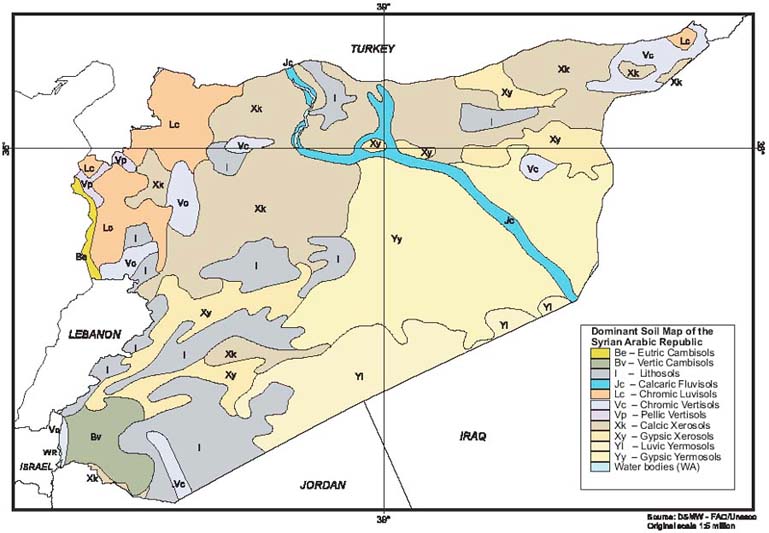The Syrian Arab Republic is a medium sized country with a total land area of about 18.5 million hectares. Of these, 13.7 million ha are used for agricultural purposes. About 60 percent of the agricultural land is permanent pasture, located mostly in steppe areas that provide about 20 percent of the total livestock feed. The total population is about 17 million, with a high annual growth rate (3.2 percent for the period 1975 to 1997, 2.4 percent projected for the period 1997 to 2015). About 50 percent of the population lives in the rural areas and depends primarily on agriculture.
The country is mainly of an agrarian economy with limited industrial and services sectors. Almost 90 percent of the merchandise exports in 1999 were primary goods, primarily agriculture-based. The livelihood and food security of the majority of the population thus depends on the natural resource base of the country, particularly on weather conditions, which are highly variable over space and time.
The natural and human resources of the agricultural sector of the Syrian Arab Republic continue to be of primary importance to the economic and social development of the country. Agriculture has continued to provide a high proportion of the food commodities required by the rapidly growing population. It contributes substantially to the Gross Domestic Product and is the major source of employment.
Agricultural exports are major earners of foreign currency and the agricultural sector continues to contribute to industrial growth, particularly since many manufacturing activities are based on agricultural raw materials. The Syrian Arab Republic was self-sufficient in major food and feed commodities during the 1960s. During the 1980s, however, domestic production could no longer meet increasing demand and the Syrian Arab Republic had to look to increased agricultural productivity and/or imports to meet its needs in many major foods and feed commodities.
The growth of the population, combined with increased demand engendered by rising incomes and urbanization have led to substantial increases in food demand in the Syrian Arab Republic, as in many other developing countries. In general, the attainment of the most economic yields and the greatest return from land and labor require substantial quantities of inputs such as improved varieties, fertilizers, and chemicals for crop protection.
In the Syrian Arab Republic, mineral fertilizers were introduced during the 1950s when they were used primarily on irrigated crops such as cotton and vegetables. In the dry areas of the Syrian Arab Republic, fertilizers were introduced during the 1960s. Farmers in the relatively wetter areas, which receive more than 350 mm annual rainfall, started their use. In the areas that receive 200 to 350 mm rainfall extensive barley is the principal crop, grown primarily for livestock feed.
The overall objective of this paper is to review fertilizer use by crops in the agro-ecological zones in the Syrian Arab Republic. The specific objectives, based on available data, are to:
a. Describe the agro-ecosystems and farming systems under which fertilizer are used in the Syrian Arab Republic.
b. Identify trends in fertilizer use, domestic production, imports and exports.
c. Assess the economic profitability of fertilizer use on a per crop basis.
Figure 1 Dominant soil map of the Syrian Arab Republic
